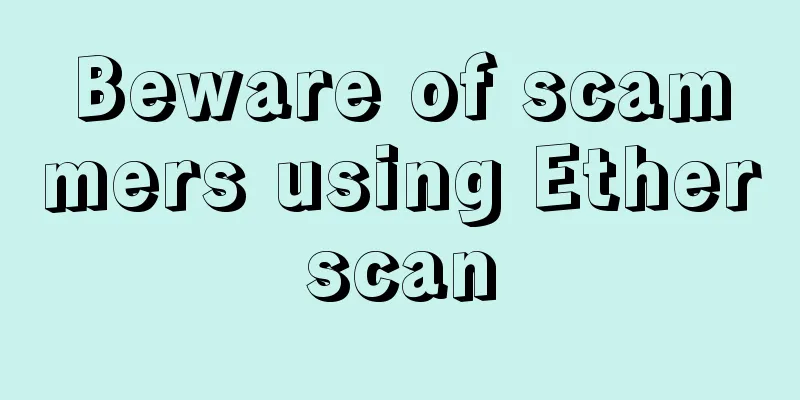Beware of scammers using Etherscan

|
Blockchain indexing services rely on contract events to help archive data and provide us with transaction records in a beautiful user interface, which is often called a "block explorer" such as Etherscan. But malicious contracts can appear to be "normal" and pollute these events, thereby deceiving block explorers and providing unsuspecting users with misleading information about the origin of tokens. For example, a malicious user could deploy a simple ERC20 contract and “airdrop” tokens to a group of users, create a seemingly healthy liquidity pool on an automated market maker, and wait for users to buy or sell tokens based on false propaganda, believing that the tokens are part of a known developer/entity. break downAn ERC20 token (which is a universal standard for token interfaces) is a collection of contract properties, functions, inputs, outputs, and events. As long as our contract has the correct functional characteristics, we can use custom logic in these functions - even functions that provide incorrect data. For example, we could have some/all block explorers display a different address to end users (in certain views) if the contract deployer sends a token. Assume the following;
This isn’t just an ERC20 issue…tainted data can be inserted into any token standard event, such as NFTs (ERC721, ERC1155), to confuse users and potential investors into thinking the project has specific parties of interest/influence when in fact it does not. This issue is not "new", but we wrote this article to highlight what is happening and what users should do before "copying" a "legitimate-looking" project. When a block explorer sees an event emitted by a transaction, they record it in their off-chain database and relate it to other data so they can build a nice graph of transaction relationships to show to the end user in their UI. Proof of ConceptWe will deploy a proof-of-concept contract using an older version of Solidity, but also prove that it works with any version of Solidity or anything in Ethereum, it is a matter of trust from the off-chain application trusting the contract. Generally speaking, the inherited trust in events is "correct", it is a way for a contract to make available data to the off-chain program for indexing. In the contract above (located at 0x3afe99bd92b1aed3237196b26743681766d4940e), we modified the logic to change the sender address in the Transfer event to the address marked as “OpenSea:Wallet” on popular block explorers, provided that we (the one who created the contract) are sending tokens. What it does is that when the block explorer indexes that event, it sees from the Transfer event that the address 0x5b32…1073 sent the tokens, instead of the actual sender 0x11b6…04C9, which could lead to this method being exploited by bad actors to trick users into thinking;
Let’s call transfer() from the contract deployer address and see what the block explorer indexes. We are just moving tokens from my address (0x11b6…04C9) to a destination address (0x4bbe…1520). The “OpenSea: Wallet” ERC20 activity view shows that it appears to have sent a token called OpenSeaRevenueShare to the destination. The transaction indicates (in “tokenTransferred”) that “OpenSea: Wallet” sent tokens to the destination address. The destination address shows that “OpenSea: Wallet” transferred 10 tokens to them. Looking for Something?Most of these malicious contracts that exploit users are not "verified", and since we only have access to the bytecode on the block explorer, if the event is tainted with bad data, it is difficult for users to verify it based on certain conditions, just like our proof of concept. If the contract is not verified, such as we cannot see the Solidity/Vyper/... code and are only exposed to the bytecode, then we should take precautions before interacting with the contract. If a token is “airdropped” to us or another entity, we should be cautious, especially when trying to liquidate tokens on a DEX, as there have been incidents in the past where artificial price creation methods have been used to steal tokens from DEXs. A quick way is to check if the event parameters match the transaction sender, this is not foolproof because the airdropper has multiple sender contracts. For example, if the transaction "From" field does not match the event, please proceed with caution. The method of polluting events with bad data is working on mainnet. A known issue. For example, if we run the following query on Google BigQuery, we can understand what is happening with the contracts that are emitting events to trick indexers into thinking that Vitalik Buterin is spending their tokens. exampleElonPlaid (0x907f3040e13bd57f3b00f89bb8ee19424a95b065) On the constructor emits a Transfer() event tainted with Vitalik Buterins address for the entire token supply. When a transaction is started using a token, a Transfer() event is emitted which is tainted with Vitalik Buterin’s address.
KenshaInu (0x3a7eaa257181719965f8ebe64bb7c13ffbbca36b) On the constructor emits a Transfer() event tainted with Vitalik Buterins address for the entire token supply.
IronDoge (0 xf6072df56114e1a1c76fe04fb310d468c9ba8c38) On the constructor emits a Transfer() event tainted with Vitalik Buterins address for the entire token supply.
These are just three of many examples of bad actors taking advantage of tainted events to defraud users, and their targets are not only Vitalik Buterin’s known addresses. SummarizeWhile block explorers are extremely useful in visualizing blockchain data, their logic can be abused to display misleading/incorrect data. The old blockchain adage of “don’t trust, verify” seems appropriate, especially when we all trust block explorers to provide absolutely accurate data without considering how they interpret the data. This is a known and potentially difficult problem to solve, and I hope this post helps people be less FOMO and more careful before “copying” a project because it makes it look like someone is invested when they aren’t. |
<<: Two dark horses emerge in the stablecoin market: USDC and UST
>>: 7 Potential Impacts of the Ukraine War on Cryptocurrency: Dangers, Hopes, and Solutions
Recommend
How to read the five elements of marriage
Everyone's future destiny is determined from ...
Hackers return stolen ETH from SpankChain platform
On October 12, according to Coindesk, a hacker wh...
What kind of palmistry brings wealth?
Everyone wants to have a pair of golden fingers t...
Palmistry Diagram: Change Line
Palmistry Diagram: Change Line Change lines: The ...
Why do some people like to show off their wealth?
Why do some people like to show off their wealth?...
European Parliament holds hearing on digital currency regulation
Baozou Commentary : For this European virtual cur...
Wu said weekly mining news: Gansu inspections and mining have entered regular supervision 0906-0912
Wu said author | Colin Wu Editor of this issue | ...
What are the characteristics of a super good-looking woman?
What is the most important part of a woman's ...
Physiognomy analysis: The woman that a diamond man wants to marry the most
Physiognomy analysis: The woman that a diamond ma...
How does a woman with a high nose but no flesh on the nose look?
The nose is an important part of our facial featu...
Ten most blessed and prosperous female faces
Ten most blessed and prosperous female faces The ...
How is it to get along with a man with four white eyes?
Four white eyes man Men with white eyes have smal...
Kraken CEO says that by 2022, one BTC will be worth as much as a Lambo and by 2023 it will be worth as much as a Bugatti.
Amid the threat of a devaluing dollar, Kraken’s J...
Palmistry for partial wealth, do you have partial wealth luck?
The so-called side income can also be called unex...
Central banks around the world are beginning to change their attitude towards Bitcoin
Author: GTong The rise of Bitcoin has led central...









